Engaging in musical activities, either through the playing of an instrument or simply listening to music, can help in the development of areas of the brain that affect our moods, motivation, and in general, the way we relate to the world. Music can help motivate us, lift our spirits, help us relax, and increase our appreciation of the beauty in the world. Through music making we reflect and ponder ideas, become creative in our thinking, and invent new ideas.
Studies show that music can have therapeutic benefits. It improves awareness of our emotions and helps us to manage different emotional states. Music can help us get in touch with our inner feelings, increasing our self-awareness. Self-awareness can help us as we cope with a wide range of emotional situations. We need to learn to recognize our own emotions and be able to manage them effectively. This in turn helps us to recognize and appreciate the emotions of others and to effectively manage our interpersonal relationships. Music instruction enhances our emotional intelligences and help spark the neurological connections that affect our emotional intelligence growth.
Another benefit of music instruction, indicated by another study cited by Jensen, is that social skills can be enhanced through musical instruction. The development of social skills is critical to school age children and musical instruction can help in this important development. It has been shown that background music can increase positive peer interactions among students. It can help students relax and that in turn helps students be more successful in their social interactions. Positive social interactions can lead to a host of other positive benefits. The development of our emotional and social skills are an important part of our everyday lives. And music has a positive affect towards the development of those skills.
Your thoughts on these comments are most welcome.
Thursday, July 23, 2009
Tuesday, July 21, 2009
The Art of Music-more thoughts on Jensen's Arts with the Brain in Mind.
Even thought this blog will mainly focus on the visual arts, I want to talk a little on the importance of music education and its inclusion in every child's education experience. Music education has a proven track record in helping to develop the maturing brain. Children should be given consistent and frequent opportunities to explore music through listening, singing and individual instrument lessons.
Music education and training offer great benefits to an individual's intellectual development. Yet it's a fact that is easy to overlook. The US education system seems to ignore past and current research regarding the benefits of a well-rounded education in the musical arts. Perhaps the fact that its importance is overlooked or downplayed is because the study in the the arts take a long while to reap rewards. A talented musician can spend years at study before the fruits of his/her labor is realized.
Much like language learning, music learning has developmental periods. Like the learning of language, these periods arrive very early in a child's life. That is not to say that people can't benefit from musical instruction later in life, but the fact is that the earlier children are taught music, the better. These developmental periods are more like temporary open windows which suggests that early music education is critical for a child to reach his or her full potential.
In his book, Arts with the Brain in mind, Eric Jensen suggests that one can begin to "play" a music instrument even before the age of 5. This is because before the age of 5 there exists a critical period for somasensory development (via musical instruction). Clearly, the home plays a significant role in a child's musical education. If by age three children are ready for simple keyboard practice, at least having musical instruments in the home will invite exploration and experimentation (through play) and prepare the child for eventual formal lessons.
With regard to music lessons, Jensen's suggests, "The sooner the better." I have two young grandchildren and they are 2 and 4 years old. When they come to visit my wife and me, I make available musical instruments for them to strum and bang on. In their home there are several instruments as well. I began playing piano as an elementary student. I also played clarinet throughout my school experience and today play guitar and other stringed instruments. Of all the musicians I've met in my life, the ones that are the most proficient are those that began playing at a very young age.
Jensen points out studies that show 9-year-olds have the ability to hear and comprehend music even when no music is playing. The brain itself is giving meaning to musical ideas and sounds and forming musical compositions. One author (on an Internet article on audiation) says that this skill is analogous to thinking in a language.
What can art educators do with these facts about musical education? I'm a great believer in playing background music during art work time. Jensen has a book that lists nearly 1000 tunes to use in a variety of learning situations. Top Tunes for Teaching can be found on Amazon.com as well as other book stores.
Jensen suggests that background music should be predictable (but this maxim is different for creative expriences--see more next paragraph). He suggests jazz instrumentals from musicians like George Bensen and Kenny G. Environmental music such as a running river, rain, or the ocean surf, combined with soft musical accompaniment is recommended as well. Baroque music works well too and Jensen suggests it be in a major key, done with orchestras (as opposed to individual instruments), and the movements must be adagio or andante. Here again balance and predictability are the key to effective background music. Some good suggestions for background music include Bach's Branderburg concertos, Handel's Water Music, and Vivaldi Four Seasons.
I stumbled upon a website, http://www.kaganonline.com, where they sell CD's that are specific in creating particular moods. On the one hand, general background music should be predictable. But Jensen says later that for creative stimulation, the musical type differs from the predictable kind.
Gary Lamb of http://www.garylamb.com/ has a collection of CDs that he's authored (which he sells at KeaganOnline). They are tailored for specific learning situations. His Music for the Mind series is for classroom use and I just bought two of them in that series (for creative stimulation). A third one I bought, Twelve Promises, falls into the category Jensen suggests on page 27 of his book. It's a jazz album with piano, guitar, and violin. Although I've used background music before, I've not picked specific music for a specific learning purpose. I've usually just played classical albums (lots of Motzart). I'm excited to try these out and see how the children respond.
I ran across a link just the other day on the benefits of integrating the musical and visual arts. I'm exploring this idea further and when I have something good to share, I will write more on that idea. If you have any thoughts or ideas on what I've said here, I would love to hear them.
Music education and training offer great benefits to an individual's intellectual development. Yet it's a fact that is easy to overlook. The US education system seems to ignore past and current research regarding the benefits of a well-rounded education in the musical arts. Perhaps the fact that its importance is overlooked or downplayed is because the study in the the arts take a long while to reap rewards. A talented musician can spend years at study before the fruits of his/her labor is realized.
Much like language learning, music learning has developmental periods. Like the learning of language, these periods arrive very early in a child's life. That is not to say that people can't benefit from musical instruction later in life, but the fact is that the earlier children are taught music, the better. These developmental periods are more like temporary open windows which suggests that early music education is critical for a child to reach his or her full potential.
In his book, Arts with the Brain in mind, Eric Jensen suggests that one can begin to "play" a music instrument even before the age of 5. This is because before the age of 5 there exists a critical period for somasensory development (via musical instruction). Clearly, the home plays a significant role in a child's musical education. If by age three children are ready for simple keyboard practice, at least having musical instruments in the home will invite exploration and experimentation (through play) and prepare the child for eventual formal lessons.
With regard to music lessons, Jensen's suggests, "The sooner the better." I have two young grandchildren and they are 2 and 4 years old. When they come to visit my wife and me, I make available musical instruments for them to strum and bang on. In their home there are several instruments as well. I began playing piano as an elementary student. I also played clarinet throughout my school experience and today play guitar and other stringed instruments. Of all the musicians I've met in my life, the ones that are the most proficient are those that began playing at a very young age.
Jensen points out studies that show 9-year-olds have the ability to hear and comprehend music even when no music is playing. The brain itself is giving meaning to musical ideas and sounds and forming musical compositions. One author (on an Internet article on audiation) says that this skill is analogous to thinking in a language.
What can art educators do with these facts about musical education? I'm a great believer in playing background music during art work time. Jensen has a book that lists nearly 1000 tunes to use in a variety of learning situations. Top Tunes for Teaching can be found on Amazon.com as well as other book stores.
Jensen suggests that background music should be predictable (but this maxim is different for creative expriences--see more next paragraph). He suggests jazz instrumentals from musicians like George Bensen and Kenny G. Environmental music such as a running river, rain, or the ocean surf, combined with soft musical accompaniment is recommended as well. Baroque music works well too and Jensen suggests it be in a major key, done with orchestras (as opposed to individual instruments), and the movements must be adagio or andante. Here again balance and predictability are the key to effective background music. Some good suggestions for background music include Bach's Branderburg concertos, Handel's Water Music, and Vivaldi Four Seasons.
I stumbled upon a website, http://www.kaganonline.com, where they sell CD's that are specific in creating particular moods. On the one hand, general background music should be predictable. But Jensen says later that for creative stimulation, the musical type differs from the predictable kind.
Gary Lamb of http://www.garylamb.com/ has a collection of CDs that he's authored (which he sells at KeaganOnline). They are tailored for specific learning situations. His Music for the Mind series is for classroom use and I just bought two of them in that series (for creative stimulation). A third one I bought, Twelve Promises, falls into the category Jensen suggests on page 27 of his book. It's a jazz album with piano, guitar, and violin. Although I've used background music before, I've not picked specific music for a specific learning purpose. I've usually just played classical albums (lots of Motzart). I'm excited to try these out and see how the children respond.
I ran across a link just the other day on the benefits of integrating the musical and visual arts. I'm exploring this idea further and when I have something good to share, I will write more on that idea. If you have any thoughts or ideas on what I've said here, I would love to hear them.
Wednesday, July 15, 2009
Thoughts on ARTS WITH THE BRAIN IN MIND
 Recently I finished an online class using Eric Jensen's book, Arts With the Brain in Mind, as the text. The next series of blogs will focus on things learned from the reading of this book and offer up some of my thoughts and attitudes towards the arts in general. I will briefly look at some of the important research information that I have discovered, share insights gained, and encourage anyone reading this blog to buy this book and read it for yourselves. After you finish it, hand it over to your principal to read it. That's what I did. I'll let you know if she read it and if something positive comes from her reading of the book.
Recently I finished an online class using Eric Jensen's book, Arts With the Brain in Mind, as the text. The next series of blogs will focus on things learned from the reading of this book and offer up some of my thoughts and attitudes towards the arts in general. I will briefly look at some of the important research information that I have discovered, share insights gained, and encourage anyone reading this blog to buy this book and read it for yourselves. After you finish it, hand it over to your principal to read it. That's what I did. I'll let you know if she read it and if something positive comes from her reading of the book.As those in the arts know only too well, when there are budget cuts to be made, the arts are often the first to suffer. This is often the case even though it's a fact that there are many benefits to individuals that engage in the arts.
The greatest benefit we can get from the arts is the ability to connect to an inner part of ourselves. Through the arts, we can express that inner part of ourselves in a way that no other discipline can bring out. For me, the guitar has been a life-long friend. I love it's sweet tones and as I play and listen to its sounds I realize, "Hey, I'm doing that!" But it's more than that; it's a way for me to express something that words cannot say.
The arts give us all a pathway to explore our inner selves and to exercise our creativity. This is true of all the art forms. The visual arts has taught me a lot about myself. Ten years ago, I was asked to develop an art program for our school (because I was thought to the the creative/artsy one). I began to discover a part of my self that I didn't realize was there. I discovered an artist within. And for the past ten years I've studied drawing techniques and in the past two years explored pottery and painting. It's been a ten year love affair.
Perhaps the best way to explain how I feel toward art was expressed by one of my 5th grade students. She wrote the following on a paper towel (I guess she couldn't find any paper). I still have it today.
On one side are a bunch of dots arranged to spell - something. But she couldn't read it after she finished, so wrote in parentheses (iT sed to mr.t) Below that she writes "Art is cool."
The other side contains what I consider a treasure:
(I will spell it the way she wrote it)
Art is fun.
Art is cool.
Are is on the populer list.
Art is a good thing to do when you a(re) mad.
Art is enteresting. (interesting)
Art can tell whut you are feelings in side.
Art can be sad sum times.
The research clearly shows that engaging in the arts helps develop the brain. More on this later. In addition to developing the brain, art can help develop the whole person. When we engage in the arts, personal expression becomes part of our daily experience. We all want to find out "who we are" and the arts can help us make important connections both to ourselves, and the world.
I have personally benefited from a lifetime of the arts. I've been an active musician all my life. I took piano lessons as a child, played clarinet all my life and took up the guitar when I was 17. I'm mostly self-taught. I've been in many bands, given and taken guitar lessons and still study and learn. There's always something new to learn about guitar playing specifically and music in general. The same has become true of the visual arts. The more I learn, the more I want to know. Drawing gives me a great deal of pleasure and is perhaps my favorite visual art expression. When I share my knowledge with my students, I often hear "ohhs" and "ahhhs" as something clicks with them. I try to bring them to discover that they can draw too.
I've seen some of the most academic challenged students flourish in my art class. They are free to express themselves in non-critical ways. Some students excel in math, others in science, still others in sports or writing. But everyone can be successful, at some level, in the visual arts. Whether painting or drawing or creating with clay, we can all experience art and enjoy it no matter our level of skill. And as we experience the joy of creating, experimenting, and expressing through the arts, we learn and grow and develop our character. The arts truly can bring us benefits that stay with us for a lifetime.
Tuesday, July 14, 2009
Drawing with Mark Kistler
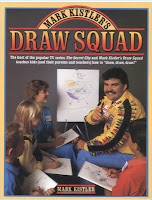 Mark Kistler's Draw Squad has been an extremely valuable resource to me. Especially for someone like myself, one with no formal art training, Kistler's ideas and explanations can take you from a unskilled drawer to a successful drawer in a few months. His ideas are simple but most of all, they are fun. I've grown to love cartooning and have found that my students will do cartoon drawings without fear. This is because in cartooning, there are no set rules on where things go. The eyes can bulge out of the top of the head. The arms can be any length and features exaggerated. In my view, this is a great way to teach students three-dimensional drawing techniques and prepare them for more advanced drawing experiences in the future.
Mark Kistler's Draw Squad has been an extremely valuable resource to me. Especially for someone like myself, one with no formal art training, Kistler's ideas and explanations can take you from a unskilled drawer to a successful drawer in a few months. His ideas are simple but most of all, they are fun. I've grown to love cartooning and have found that my students will do cartoon drawings without fear. This is because in cartooning, there are no set rules on where things go. The eyes can bulge out of the top of the head. The arms can be any length and features exaggerated. In my view, this is a great way to teach students three-dimensional drawing techniques and prepare them for more advanced drawing experiences in the future. When I first started using Kistler's ideas, he had 10 Key Words listed in his book. They have now been reduced to seven, with shading and shadows combined. Forshortening: Distorting objects or parts of an object to create the illusion that one edge is actually closer to your eye.
When I first started using Kistler's ideas, he had 10 Key Words listed in his book. They have now been reduced to seven, with shading and shadows combined. Forshortening: Distorting objects or parts of an object to create the illusion that one edge is actually closer to your eye. Shading (and shadows)
 Adding darkness to a surface that is opposite an imaginary light source adds depth to your drawing. Originally there was "shadows" as a separate category which covered the cast shadow, hover shadow and overhang shadow.
Adding darkness to a surface that is opposite an imaginary light source adds depth to your drawing. Originally there was "shadows" as a separate category which covered the cast shadow, hover shadow and overhang shadow. Surface: Drawing objects or parts of an object lower on the surface of the paper makes them appear closer (with exception of objects in space i.e. birds, clouds).
Surface: Drawing objects or parts of an object lower on the surface of the paper makes them appear closer (with exception of objects in space i.e. birds, clouds). Size: Generally, objects drawn larger will look closer, except when overlapping.
Size: Generally, objects drawn larger will look closer, except when overlapping.  Contour Lines: Lines wrapped around the contour of a round object adds volume and shape to the object.
Contour Lines: Lines wrapped around the contour of a round object adds volume and shape to the object.
Overlapping: Objects drawn in front of others will make the front
objects appear closer.
 Density: Images drawn darker, and with more detail, will appear closer than images drawn lighter and with less detail. This adds "atmosphere" to the drawing.
Density: Images drawn darker, and with more detail, will appear closer than images drawn lighter and with less detail. This adds "atmosphere" to the drawing.Here are a few samples of my students' work. I'm working on a website where I hope to include many more examples of student art work. Stay tuned:


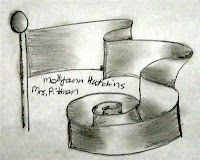



And here are a few of mine. I love to draw with the kids.


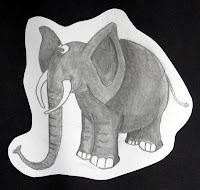
For more information see:
Mark Kistler dot Com
Draw Squad dot Com
Mark Kistler's Art Gallery
Draw3d.com
Wednesday, July 8, 2009
Drawing with Mona Brookes
 I was first introduced to Mona Brookes' Drawing With Children a few years before becoming the art teacher. Upon reviewing the book, I was impressed with the results Mona Brookes' methods achieved and looked for ways to teach her ideas in my classroom (I was teaching a multi-age 2/3 classroom at this time). But it wasn't until I began teaching as the art specialist that I was able to fully implement her ideas.
I was first introduced to Mona Brookes' Drawing With Children a few years before becoming the art teacher. Upon reviewing the book, I was impressed with the results Mona Brookes' methods achieved and looked for ways to teach her ideas in my classroom (I was teaching a multi-age 2/3 classroom at this time). But it wasn't until I began teaching as the art specialist that I was able to fully implement her ideas.I have used the "Monart" approach with my 2nd and 3rd graders for the past ten years. The ideas in the book are very easy to impliment. The lessons are step by step and well organized. In the beginning of using Brookes' approach, I followed the book exactly. These days I have to cut corners as I have only 39 meetings a year with each classroom and there are 6 days in between teaching sessions. I don't view it as advanced drawing instruction but it certainly served me well as an introduction to the art of drawing.
 The Monart method identifies five basic elements of shape (see chart on the left). All drawings can be reduced to one or all of these five shape families. It should be noted that the method in the book concentrates on basic lines and shapes but that some drawings the children will produce contain more advanced line and shape. Check out the following links for some examples of student work.
The Monart method identifies five basic elements of shape (see chart on the left). All drawings can be reduced to one or all of these five shape families. It should be noted that the method in the book concentrates on basic lines and shapes but that some drawings the children will produce contain more advanced line and shape. Check out the following links for some examples of student work.More information can be found at http://www.monart.com/. Also of interest is http://www.indydrawingschool.com/.
Here are a few samples of my student's art work from lessons contained in Drawing With Children.






Wednesday, July 1, 2009
Drawing with Ed Emberly
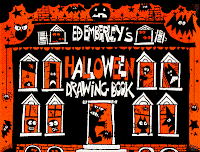
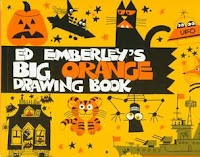 I thought I would share a bit of how I use Ed Emberley's drawing alphabet in my classroom. I needed to find an easy way to teaching drawing ideas to first graders. I actually use Emberly's ideas with all grades (to some extent) but my main focus is with K-1.
I thought I would share a bit of how I use Ed Emberley's drawing alphabet in my classroom. I needed to find an easy way to teaching drawing ideas to first graders. I actually use Emberly's ideas with all grades (to some extent) but my main focus is with K-1.I believe an important part of any drawing experience should include plenty of time where children are left alone to draw in their own way. I also think it's important to give children the tools they need to grow and change.
Very young children are learning about colors and shapes and Ed Emberley's drawing alphabet is an excellent resource for both teaching about shapes and teaching basic drawing skills. Children can be taught to look for different shapes in their world. And they can be taught to think about what shapes they see in the different things they want to draw.
 Emberley's drawing alphabet consists of the lines and shapes in the chart on the left. From these simple shapes, simple drawings can be made.
Emberley's drawing alphabet consists of the lines and shapes in the chart on the left. From these simple shapes, simple drawings can be made.Emberley's books show a step-by-step for each of his drawings. If you've never used his techniques before, I can tell you that in my experience, it's a hit with the kids. Most young children can draw simple shapes and lines and putting them together is easy for most. Older students who struggle with more advanced concepts can easily draw most of Emberley's characters.
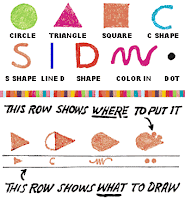 I start introductory lessons by demonstrating the drawings using my document camera. At first I draw, then they copy. So for example I'll say, "Draw a triangle like this." "Now add a half circle and color them in like this." etc...
I start introductory lessons by demonstrating the drawings using my document camera. At first I draw, then they copy. So for example I'll say, "Draw a triangle like this." "Now add a half circle and color them in like this." etc...After completing a few of these drawing, the children catch on to how the steps work and they are ready to draw on their own. When I introduce more difficult drawings, I demonstrate those first and let the students work on their own. I personally draw many examples of drawings and make copies available for children to practice with. (I don't allow tracing, but copying what they see is encouraged.)
I have purchased several of Emberley's books and also made copies of selected step-by-step drawings. I make these available to the children. A usual lesson will include a time where children use the handouts to draw images of their choosing and then add other ideas and details to their drawings. Along with Emberley's books, I have found several other books that fit well into his drawing alphabet approach.
Here are some student samples (various grade levels). One of the biggest hits of Emberley's book collection is the Halloween books. Even the 5th graders like drawing the Ed Emberley way and this is especially true at Halloween.
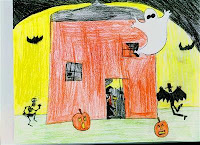



Please feel free to leave your comments and questions (or post question on the discussion list). I hope you find something you can use in your room. And if you have ideas to share, I'd love to hear from you. Dan
Ed Emberley's Drawing Made Simple
Ed Emberley's Drawing Book of Halloween
Ed Emberley's Big Orange Drawing Book
